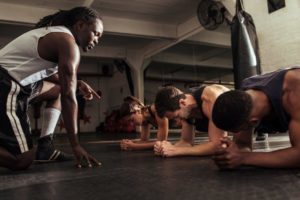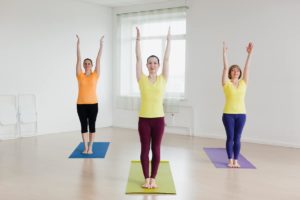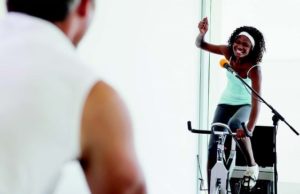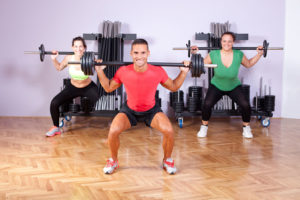Strong Starts
The warmup. Is it simply a time for small talk while people trickle in, or is it an opportunity to ignite attendees’ best efforts? This may be the class section that fitness instructors plan the least, yet devoting some time to designing the warmup is really worthwhile. Why? Because starting on a strong note significantly affects the outcome of the entire workout. We want our participants to get the most from our classes, so let’s set them up for success.
Strength Ladder
Strength training classes don’t have to adhere to a classic “sets and reps” template. Why not climb your way up and down this fun fitness ladder for a fast and furious total-body workout? Repetitions are high, but so is the frequency of change, keeping interest piqued during intense work sets.
Strength Ladder Details
GOAL/EMPHASIS: total-body strength training
TOTAL TIME: 1 hour
How to Help Participants Find Flow
For a moment, think about your own workouts. Tap into that feeling of being completely absorbed in your favorite fitness routine. Everything else fades away, and your entire focus is on the present moment. You feel confident in your body’s abilities, you’re challenging yourself, and you find great meaning in what’s happening now. You’re in the zone. Before you know it, your workout is over, and you can’t wait to do it again.
Sample Class: Step With Variations
Step classes are still alive! Many participants remain eager for creative yet easy-to-follow choreography. You can keep yours simple while retaining some of the frills that people enjoy. Here’s an example: This class starts with one 32-count step combination for the warmup and continues with four variations on that combo during the main segment. Try this choreography during your next step class.
Step With Variations Details
GOAL/EMPHASIS:cardiovascular workout with classic 32-count step choreography
Teaching Yoga at the Wall
As a yoga teacher, you guide participants through a practice that deepens their understanding of asanas (poses) and how these take shape in students’ bodies. You cue, coach, align, adjust, demonstrate and discuss, and you offer tips on breathing, anatomy, “feel” and sensation. Often, the most effective way to help participants understand a specific element is to slow down, grab a prop or two, and work a little deeper. You may have access to straps, blocks and bolsters, but you might be forgetting another perfect “prop”: the wall.
Where Your Career Goes From Great to EPIC
The IDEA World Convention means a lot of things to different people. For some, it’s primarily about updating their skill sets and knowledge to maintain a competitive edge. For others, the connections and relationships they build at the fitness event are priceless in advancing their careers and enriching their lives. Whatever stands out for each individual, one thing unites allIDEA World attendees: an intense desire to create a career that thrives.
Making Connections That Boost Career Success
Turn Negatives Into Positives
I was a new group fitness instructor taking someone else’s muscle-toning class. “You’re not going low enough,” the instructor yelled at me from across the crowded room. As flames of embarrassment burned my cheeks, I dropped lower into the Romanian dead lift even though I had just come from teaching my seventh cycling class of the week and my body was spent. But this was what the class required, I rationalized, and I was fit—I should be able to keep up.
Unfortunately, I couldn’t keep up, and as a result, I gave myself a nagging lower-back injury.
Streamline Your Yoga Cuing
When you were new to teaching yoga, you had a lot to focus on. You navigated the room, demonstrated poses, gave hands-on adjustments, held space for emotions and skillfully managed time. In the early days, it may have felt like a victory just to make it through a class successfully!
Crystal-Clear Cuing for Indoor Cycling
Walk by any indoor cycling studio when a class is in session and you're likely to hear a variation of the following:
"I want everyone at a 2!"
"Push yourself to a 7 and hold it there for 30 seconds!"
"Let's start at a 3, turn up to 6, and then come back to a steady 4. Go!"
The key to unlocking a fantastic cycling class is somewhere in those numbers, but your members may find themselves shut out if they don't know what you're referring to.
Eight Principles of Behavior Modification
The ongoing and stubborn health epidemic in the United States, combined with healthcare reform and a growing body of behavior change research, has sparked a revolution. It has become clear that “expert advice” does not translate into behavior change for people who are not ready to change. After all, despite doctors’ orders, nearly a third of prescriptions are left unfilled (Tamblyn et al. 2014). Despite federal dietary guidelines, the average American’s food intake lines up with MyPlate recommendations on only 2% of days (NPD Group 2011).
Practice Techniques For Pilates Instructors To Emphasize
Michele Olson, PhD, FACSM, professor of exercise science at Auburn University in Montgomery, Alabama, and Cherie Wells, lecturer in physiotherapy and clinical education coordinator at the University of Western Sydney in Penrith, Australia, both lead investigators of multiple Pilates studies, offer the following research-based practical tips on what mind-body fitness professionals should emphasize to maximize Pilates benefits for clients:
5 Tips for Teaching Multilevel Classes
Learning to teach multilevel Pilates mat classes can challenge even the most seasoned pros because we have to master so many specific movements and breathing patterns.
To simplify things, I devised the PESTT protocol—five tips for developing a plan that uses specific cuing and demonstrating techniques to keep classes challenging, engaging and safe at every level.
The 3-Core BodyMapping Perspective
Over my 40 years of teaching, I have come to deeply appreciate the innate intelligence of the body. I have learned to listen to its messages. Out of this appreciation and listening I have developed the 3-Core BodyMapping Perspective
The SIMPLE Secret to a Successful Exercise
Using an easy-to-remember word as a “checklist” is a fun way to set up your client for success. Here are the six steps I go through when teaching the Pilates repertoire. I’ve found this checklist covers it all–from fundamentals to higher-level exercises.
The Essential Cue: Reformer
Many exercises in the Pilates repertoire involve thoughtful and calculated initiation before you even begin the movement. Can’t feel the muscle focus? Don’t understand the objective? Then you’re cheating! The art of providing proper cues to clients is crucial to their success. Let’s explore a few exercises specific to the reformer and share ideas on how best to “tell a story” using a variety of cuing avenues.
Teaching Pilates Mat Work, Part 1
“It is the spirit that builds the body.” This quote from 18th century German poet Friedrich Schiller was displayed–in its original language–in Joseph Pilates’ New York studio for more than 50 years.
The Art of Cuing
How often have you given a cue and had a client respond, “Oh, now it makes sense!” or “Wow, that feels totally different!” or of course my favorite, “No one has ever told me that!” A well-directed cue that hits the mark can bring about a change immediately.
Strategic Communication
What is the best way to communicate with clients? Begin by recognizing primary sensory modalities, and incorporate this knowledge into your cuing.
Successful Cuing for Pilates
Tailor your cues to your clients' preferred methods of learning.










